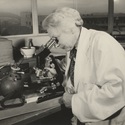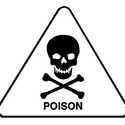Mercury – named after a Roman god known for speed and agility – is a chemical element that has fascinated humans for thousands of years. Mercury is the only metallic element that is liquid under standard conditions. It flows easily and has very high surface tension, so it forms shiny rounded beads. When compared with most other metal elements, which are usually bits of greyish solids that tarnish quickly, it’s easy to see why mercury was thought to have special properties.
Elemental facts
Mercury’s official chemical symbol is Hg, from the Greek word ‘hydrargyrum’, meaning ‘liquid silver’ or ‘water silver’. Its atomic number is 80, which means that a mercury atom has 80 protons in its nucleus. Mercury is rarely found in its elemental form. It is most often found in cinnabar, a form of mercury sulfide.
A metal of antiquity
Mercury is one of the seven metals of antiquity – metals that humans identified and used in ancient times. The other metals of antiquity are gold, silver, copper, iron, tin and lead. The alchemists thought that mercury was very special – the matter from which all metals were formed. It represented solid and liquid, heaven and Earth, and life and death. It is the only metal of antiquity that is still referred to by its planetary name.
Humans had uses for mercury long before the alchemists tried to use it to turn base metals into gold. Egyptian tombs dating from 1500 BC held vials of liquid mercury. Its use in China and India dates before 2000 BC. Mercury and other precious items were found in the depths of an 1800-year-old pyramid in Mexico.
Mercury was long considered as a means to promote health. Chinese emperors consumed mercury to prolong their lives. It is rumoured an Egyptian ruler had a mercury bath on which he was rocked to sleep. Mercury had other uses as teething powder, an antiseptic and even as a laxative. It is reported that the American explorers Lewis and Clark and their crew took 600 mercury laxative pills with them as they travelled across the wilderness. The reports don’t tell us how effective the pills were, but archaeologists have been able to track the campsites used by the explorers due to mercury deposits in the latrines they dug in the soil!
A toxic element
We now know that mercury (and most of its compounds) are very toxic. It causes damage to the human nervous, digestive and immune systems and to kidneys, lungs, liver, skin and eyes. Elemental mercury is easily absorbed into the body if we inhale or ingest it or if it comes in contact with an open wound.
The phrase ‘mad as a hatter’ came from the psychological symptoms displayed by those who used mercury compounds to make felt hats during the mid-18th to mid-19th centuries.
Mercury occurs naturally in coal and other fossil fuels. When we burn these to produce energy, mercury goes into the atmosphere. It returns via rainfall or as dust and is deposited in soil or water. Microorganisms in the water can change mercury to methylmercury, and this can build up in fish and shellfish through bioaccumulation. For most people though, the benefits of eating fish outweighs the risk of harm from methylmercury. On the other hand, it is one more reason to promote the use of clean energy sources.
Modern uses
Due to its toxicity, we no longer use mercury in consumer items such as thermometers. New technology has also replaced mercury in other types of electrical and medical devices.
Mercury is still used to extract gold from rocks in small operations. When the two elements come into contact, gold dissolves into the mercury. This technique lost favour in New Zealand in the 1890s when cyanide was found to be more effective.
Mercury is still used in scientific research, including liquid mirror telescopes, and the Deep Space Atomic Clock, designed for space probes.
Related content
Temperature – the hot and the cold is an interactive timeline that displays mercury’s freezing point and boiling point.
Toxins and food webs explains how marine toxins bioaccumulate.
Useful links
Read about mercury and health:
- New Zealand Ministry for the Environment
- World Health Organization
- United States Environmental Protection Agency
Find out how liquid mirror telescopes work.








